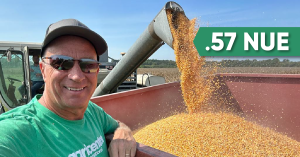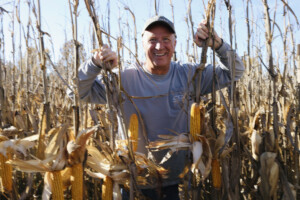“They’re on 30s, we’re on 36s.” The cultural practice of row width is often as defining to a farm as the color of tractors they drive. Row width speaks to how far apart you plant your rows. This can vary greatly depending on the crop, geography, agronomic challenges and what the farmer wants to achieve. Here’s a look at some considerations. As with nearly all aspects of farming, there are always trade-offs.
- Equipment set-up. Among corn and cotton growers, the first criteria is to match the width of your planter rows to the width of the header on your combine. If your planter’s row units are set to 30”, and your corn head is set for 36 inches, you’ll have a near impossible task of harvesting your crop. Small grains, soybeans and sorghum, which utilize a grain platform and reel for harvest, make any planter width possible. Many farmers utilize legacy systems, as planters and harvest headers are very expensive. Based on equipment investments, changeovers to different row widths can get expensive. So these decisions aren’t made lightly.
- Crop. Small grains are often drilled in 7.5” rows, soybeans are frequently grown in 15- or 20-inch rows, corn in standard 30” rows and cotton in wide, 36” or 38” rows. But these can all be modified.
- Geography. This usually relates to annual rainfall and water availability, which plays a key role in choosing row spacing. Drive through northern Ohio and you’ll see drilled soybeans. That’s because that area receives high amounts of rainfall that neutralizes the competition between plants. Yes, crops don’t just compete against weeds, they also compete with one another for water, nutrients and sunlight. In the Mississippi Delta (where my test farm is located) furrow irrigation is a widely utilized practice, so you’ll see many 36” and 38” rows.
- Weeds and pests. Many soybean growers opt for narrow-row or drilled rows to combat weed pressure. Unlike corn, soybeans are a shorter and slower-growing crop, so it takes them longer to shade the rows. But in areas where diseases such as white mold are an issue, growers may plant wider 30” rows to get more air through the crop canopy, so it in-turn becomes less of an incubator for disease.
- Regen ag. A practice growing corn in 60” rows is catching traction among progressive soil health advocates. That enables them to plant cover crops early in the year and build lots of biomass to improve the health of their soil and potentially use the covers as feed for cattle.
Growing up, nearly all our western Illinois neighbors grew wheat. For us, we needed the straw to bed our cattle and hogs, as well as diversify our operation. But the rise of specialization brought about the demise of wheat growers, in terms of sheer numbers. This decade alone, the number of farms growing wheat has dropped a whopping 43%. There are now less than 100,000 farms across America’s breadbasket growing the world’s primary energy source. Sure, as is the case with most commodity crops, wheat farms have gotten bigger. Yet planted US acres have fallen from over 60 million to now less than 50 million. The trend figures to continue in 2024, with projected acreage figuring to drop 4% to 47.5 million. The thing with wheat is, there’s always been a big gap between what’s planted and what’s harvested. Historically, over 20% of wheat acres never see a combine. Many farmers across the South and Plains grow wheat pasture to graze cattle. The growing regen ag movement, along with the crop’s ability to establish quickly, pair with legumes, and produce high amounts of biomass, makes wheat a popular cover crop.
Related Posts

This Week in Ag #47
Nitrogen Use Efficiency has quickly become part of the vocabulary surrounding sustainability. But NUE is more than just a buzzword or another fancy acronym. NUE is the benchmark for nitrogen management. You’ll often see it used to measure the amount of nitrogen used to produce a bushel of grain. NUE is a pillar for calculating

This Week in Ag #31
#Harvest23 is here! If all goes well, I should be harvesting my corn plot this week. The beginning of fall brings excitement and optimism to the farm. But this year, those feelings appear tempered. Farmer sentiment dropped 8 points last month (according to the Purdue Ag Economy Barometer) as producers shared a dimming view of

This Week in Ag #51
Back in the mid-1980s, this then-high school student attended a farmer meeting with dad. One of the speakers was a commodities advisor. He playfully asked the attendees what their target price was for their crops. He further inquired, “How many of you are still holding out for the return of $12 soybeans?” The sheepish looks

